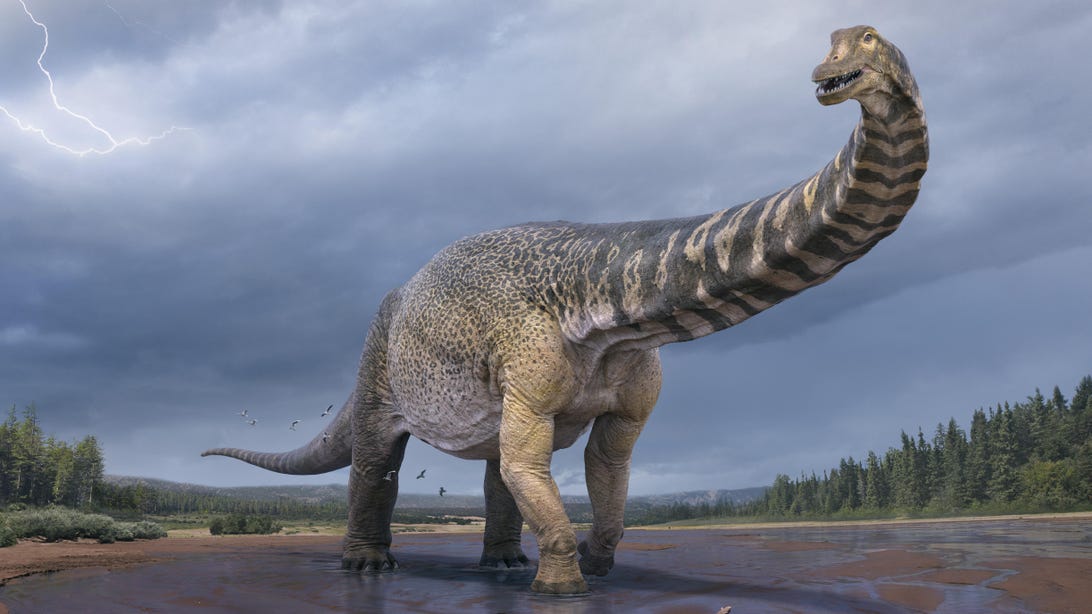
The biggest dinosaur ever discovered in Australia: Australotitan.
Queensland MuseumSome 92 million years ago, "Cooper" got stuck in the mud. The slop sealed the fate of the gigantic, long-necked leaf-eating dinosaur, concealing its bones until 2007, when the beast's parts were unearthed, dug out from beneath a cattle and sheep station near the small Australian town of Eromanga, population 119, in southwest Queensland.
After 14 years of painstaking research and analysis, the gigantic sauropod specimen, known from leg and hip bones, is being described and officially named by its discoverers for the first time. The nickname, Cooper, is out.
Folks, it's time to meet Australotitan cooperensis, a titanosaur that lorded over the land during the Cretaceous period, some 92 million to 96 million years ago. The name Australotitan means "southern titan," and cooperensis represents the area where the fossil was discovered.
The holotype specimen -- that is, the specimen used to describe this brand new species -- is detailed in a paper, published in the journal PeerJ on Monday, by researchers from the Queensland Museum in Australia and the Eromanga Natural History Museum.
"This new titanosaurian is the largest dinosaur from Australia represented by osteological remains," said Robyn Mackenzie, a paleontologist from the Eromanga Natural History Museum.
This CG reconstruction of Australotitan cooperensis shows just how massive the beast was.
Queensland MuseumFor years, the research team slowly dug out the fossil pieces of Cooper and analyzed them, to get a better understanding of the gargantuan creature. They uncovered a raft of different bones and bone fragments from the titan's legs and hip.
With the help of 3D computer analysis, the team began to unravel the story of Cooper and make estimates about its size, length and mass.
"The 3D scans we created allowed me to carry around thousands of kilos of dinosaur bones in a 7kg laptop," said Scott Hocknull, a paleontologist from the Queensland Museum who helped unearth Cooper.
Titanic might be an understatement.
At almost 100 feet long, Cooper is about the length of an Airbus A318 passenger plane and out-monsters the tallest giraffe to have ever lived, which would have, at full stretch, reached up to Cooper's hip. Imagine how much extra height Cooper gets with that neck! Based on other sauropod measurements, it's likely Cooper weighed almost 70 tons -- about 10 times more than an African elephant. This puts it in the top 5 heaviest sauropods ever discovered and within the top 15 for length.
The bones also suggested that after Cooper met its fate in the mud, other sauropods trampled on his bones. A potentially grim end.
To ensure they'd found a completely new species, the team also compared the bones to those of previously described sauropods from the location, Wintonotitan, Diamantinasaurus and Savannasaurus -- which Hocknull and others have unearthed and published about in the last decade. Subtle differences in the bones of these creatures show how Australotitan differs from the other titanosaurs.
The location of the find, near Eromanga, has become something of a hotspot for dinosaur discoveries in Australia. Back in 2004, Robyn's son Sandy found an unusual rock and threw it in the back of his ute. Eventually, his father took it to the museum for analysis, and it was confirmed as a dinosaur fossil. But that was just the beginning.
"The discovery of Australia's largest dinosaur was totally unexpected and, as it has turned out, was just the tip of the iceberg of numerous significant dinosaur discoveries that has come since," said Robyn Mackenzie. Mackenzie and her family were able to establish the Eromanga Natural History Museum, which now proudly displays Cooper, on the back of the find.
The team have located a number of other titanosaur specimens but have not yet been able to say whether these are other Australotitans or other species. But the digs will continue in the land of the giants.
from CNET https://ift.tt/3v1FLoe
via IFTTT



No comments:
Post a Comment